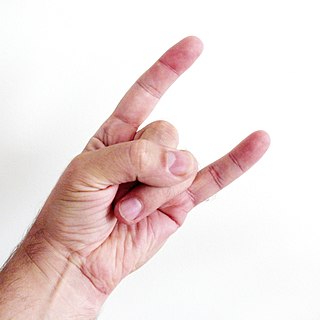In linguistics, a false friend is a word in a different language that looks or sounds similar to a word in a given language, but differs significantly in meaning. Examples of false friends include English embarrassed and Spanish embarazado 'pregnant'; English parents versus Portuguese parentes and Italian parenti ; English demand and French demander 'ask'; and English gift, German Gift 'poison', and Norwegian gift 'married'.
A facial expression is one or more motions or positions of the muscles beneath the skin of the face. According to one set of controversial theories, these movements convey the emotional state of an individual to observers. Facial expressions are a form of nonverbal communication. They are a primary means of conveying social information between humans, but they also occur in most other mammals and some other animal species.

Respect, also called esteem, is a positive feeling or deferential action shown towards someone or something considered important or held in high esteem or regard. It conveys a sense of admiration for good or valuable qualities. It is also the process of honoring someone by exhibiting care, concern, or consideration for their needs or feelings.

Body language is a type of communication in which physical behaviors, as opposed to words, are used to express or convey information. Such behavior includes facial expressions, body posture, gestures, eye movement, touch and the use of space. The term body language is usually applied in regard to people but may also be applied to animals. The study of body language is also known as kinesics. Although body language is an important part of communication, most of it happens without conscious awareness.

A gesture is a form of non-verbal communication or non-vocal communication in which visible bodily actions communicate particular messages, either in place of, or in conjunction with, speech. Gestures include movement of the hands, face, or other parts of the body. Gestures differ from physical non-verbal communication that does not communicate specific messages, such as purely expressive displays, proxemics, or displays of joint attention. Gestures allow individuals to communicate a variety of feelings and thoughts, from contempt and hostility to approval and affection, often together with body language in addition to words when they speak. Gesticulation and speech work independently of each other, but join to provide emphasis and meaning.

Greeting is an act of communication in which human beings intentionally make their presence known to each other, to show attention to, and to suggest a type of relationship or social status between individuals or groups of people coming in contact with each other. Greetings are sometimes used just prior to a conversation or to greet in passing, such as on a sidewalk or trail. While greeting customs are highly culture- and situation-specific and may change within a culture depending on social status and relationship, they exist in all known human cultures. Greetings can be expressed both audibly and physically, and often involve a combination of the two. This topic excludes military and ceremonial salutes but includes rituals other than gestures. A greeting, or salutation, can also be expressed in written communications, such as letters and emails.

Nonverbal communication (NVC) is the transmission of messages or signals through a nonverbal platform such as eye contact (oculesics), body language (kinesics), social distance (proxemics), touch (haptics), voice (paralanguage), physical environments/appearance, and use of objects. When communicating, we utilize nonverbal channels as means to convey different messages or signals, whereas others can interpret these message. The study of nonverbal communication started in 1872 with the publication of The Expression of the Emotions in Man and Animals by Charles Darwin. Darwin began to study nonverbal communication as he noticed the interactions between animals such as lions, tigers, dogs etc. and realized they also communicated by gestures and expressions. For the first time, nonverbal communication was studied and its relevance questioned. Today, scholars argue that nonverbal communication can convey more meaning than verbal communication.
Criminal tattoos are classified in different ways. The meaning and histories of criminal tattoos vary from country to country, and they are commonly assumed to be associated with gang membership. They could also be a record of the wearer's personal history—such as their skills, specialties, accomplishments, incarceration, world view and/or means of personal expression. Tattoos have been empirically associated with deviance, personality disorders, and criminality. There is no direct correlation between tattoos and criminals, but we can observe the developed history of tattoos and their meanings in countries such as Australia, France, Italy, Japan, Russia, and the United States.
In linguistics, prosody is the study of elements of speech that are not individual phonetic segments but which are properties of syllables and larger units of speech, including linguistic functions such as intonation, stress, and rhythm. Such elements are known as suprasegmentals.

The OK gesture or OK sign or ring gesture is performed by joining the thumb and index finger in a circle, and holding the other fingers straight or relaxed away from the palm. Commonly used by scuba divers, it signifies "I am OK" or "Are you OK?" when underwater. In most English-speaking countries it denotes approval, agreement, and that all is well or "okay". In other contexts or cultures, similar gestures may have different meanings including those that are negative, offensive, financial, numerical, devotional, political, or purely linguistic.

The sign of the horns is a hand gesture with a variety of meanings and uses in various cultures. It is formed by extending the index and little fingers while holding the middle and ring fingers down with the thumb.

Oculesics, a subcategory of kinesics, is the study of eye movement, behavior, gaze, and eye-related nonverbal communication. The term's specific designation slightly varies apropos of the field of study. Communication scholars use the term "oculesics" to refer to the investigation of culturally-fluctuating propensities and appreciations of visual attention, gaze and other implicitly effusive elements of the eyes. Comparatively, medical professionals may ascribe the same appellation to the measurement of a patient's ocular faculty, especially subsequent a cerebral or other injury.

Finger-counting, also known as dactylonomy, is the act of counting using one's fingers. There are multiple different systems used across time and between cultures, though many of these have seen a decline in use because of the spread of Arabic numerals.

A facepalm is the physical gesture of placing one's hand across one's face, lowering one's face into one's hand or hands or covering or closing one's eyes. The gesture is often exaggerated by giving the motion more force and making a slapping noise when the hand comes in contact with the face. The gesture is found in many cultures as a display of frustration, disappointment, exasperation, embarrassment, horror, shock, surprise, exhaustion, sarcasm, shame, or incredulous disbelief.

The fig sign is a mildly obscene gesture that uses a thumb wedged in between two fingers. The gesture is most commonly used to ward off the evil eye, insult someone, or deny a request. It has been used at least since the Roman Age in Southern Europe and parts of the Mediterranean region, including in Turkish culture. Some countries in Asia, Slavic cultures and South Africa use it too. It is used playfully in Northwestern Europe and North Africa, countries such as the US, Canada, Australia, Libya, Tunisia and Czech Republic to pretend to take the nose off a child.
An obscene gesture is a movement or position of the body, especially of the hands or arms, that is considered exceedingly offensive or vulgar in some particular cultures. Such gestures are often sexually suggestive.
Cultural communication is the practice and study of how different cultures communicate within their community by verbal and nonverbal means. Cultural communication can also be referred to as intercultural communication and cross-cultural communication. Cultures are grouped together by a set of similar beliefs, values, traditions, and expectations which call all contribute to differences in communication between individuals of different cultures. Cultural communication is a practice and a field of study for many psychologists, anthropologists, and scholars. The study of cultural communication is used to study the interactions of individuals between different cultures. Studies done on cultural communication are utilized in ways to improve communication between international exchanges, businesses, employees, and corporations. Two major scholars who have influenced cultural communication studies are Edward T. Hall and Geert Hofstede. Edward T. Hall, who was an American anthropologist, is considered to be the founder of cultural communication and the theory of proxemics. The theory of proxemics focuses on how individuals use space while communicating depending on cultural backgrounds or social settings. The space in between individuals can be identified in four different ranges. For example, 0 inches signifies intimate space while 12 feet signifies public space. Geert Hofstede was a social psychologist who founded the theory of cultural dimension. In his theory, there are five dimensions that aim to measure differences between different cultures. The five dimensions are power distance, uncertainty avoidance, individualism versus collectivism, masculinity versus femininity, and Chronemics.
Hand gestures are used in regions of Italy and in the Italian language as a form of nonverbal communication and expression. The gestures within the Italian lexicon are dominated by movements of the hands and fingers, but may also include movements of facial features such as eyebrows, the mouth and the cheeks. Theories persist as to the exact origin of hand gestures as a method of communication in Italy, however it is likely that they emerged through necessity as a universal, non-verbal method of communicating across different Italian local languages and dialects. Despite the majority of today's Italian population speaking Italian, hand gestures have persisted as a method of expression to accompany verbal speech in many regions of Italy.

A nonmanual feature, also sometimes called nonmanual signal or sign language expression, are the features of signed languages that do not use the hands. Nonmanual features are grammaticised and a necessary component in many signs, in the same way that manual features are. Nonmanual features serve a similar function to intonation in spoken languages.












